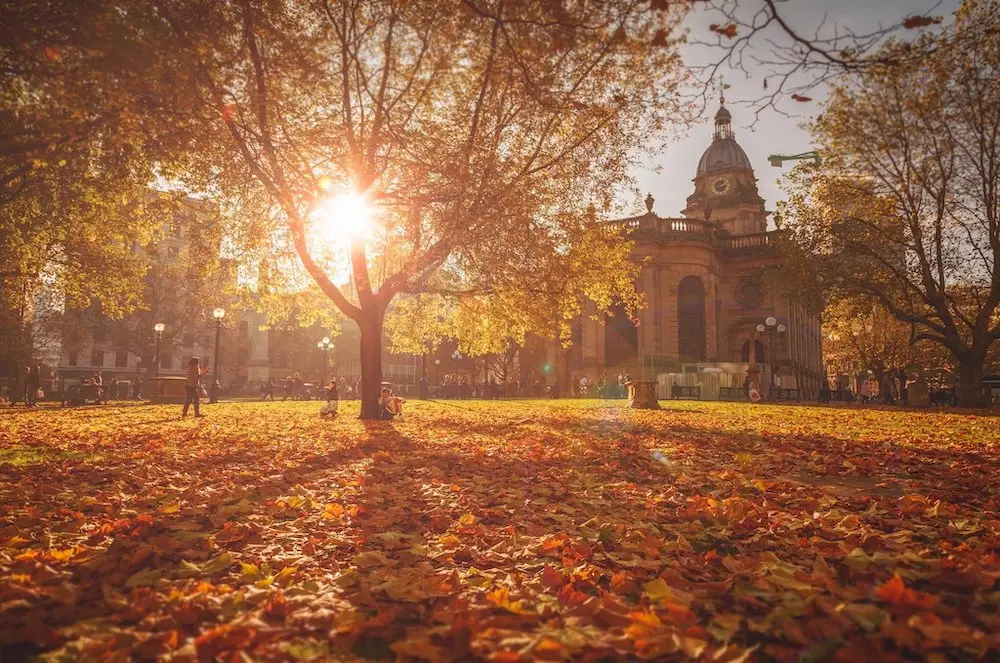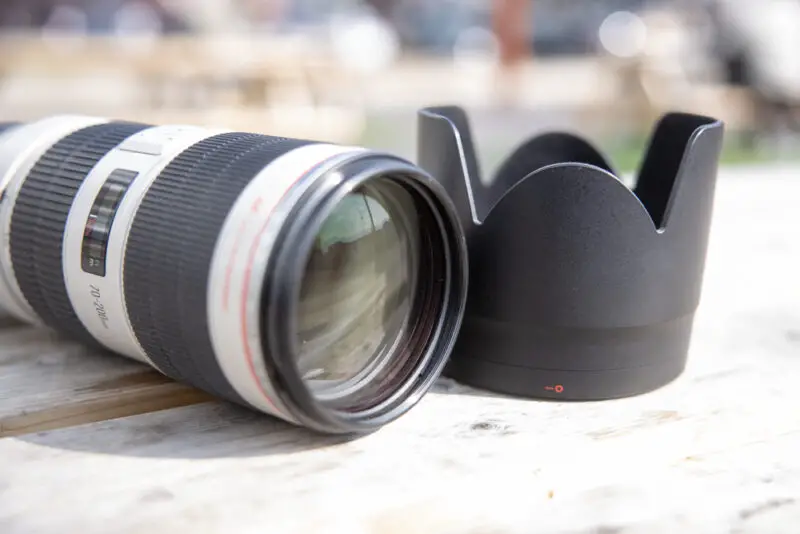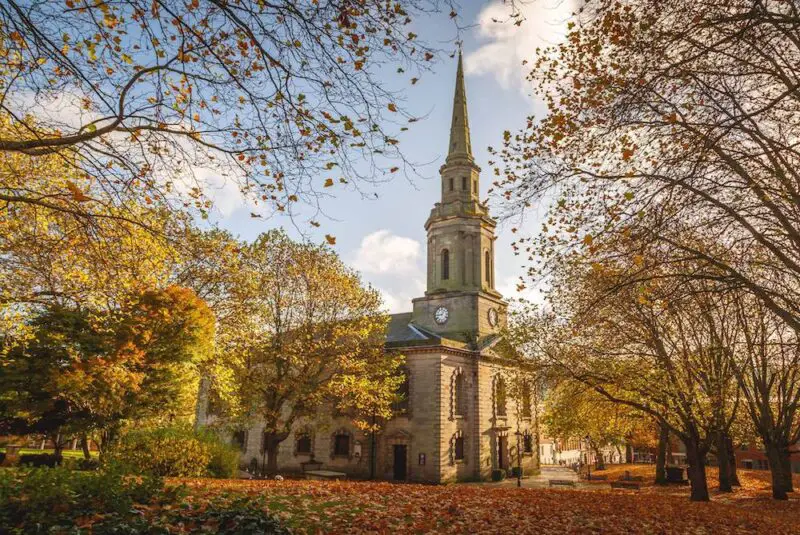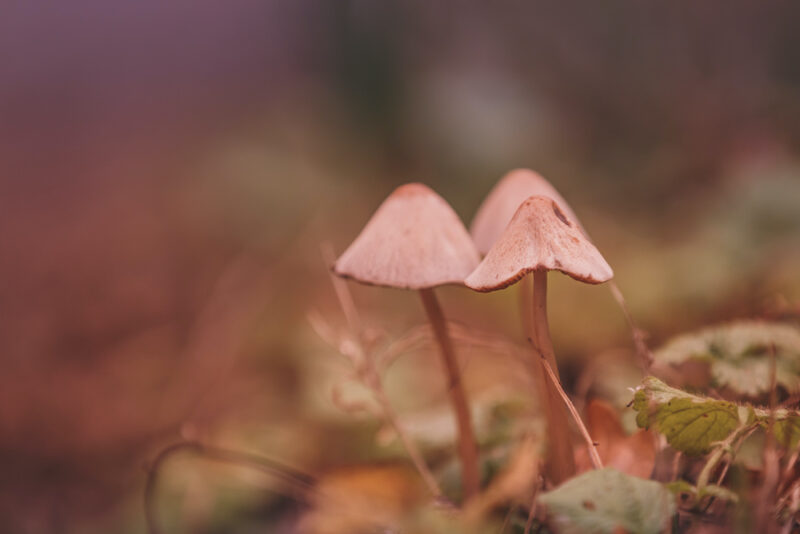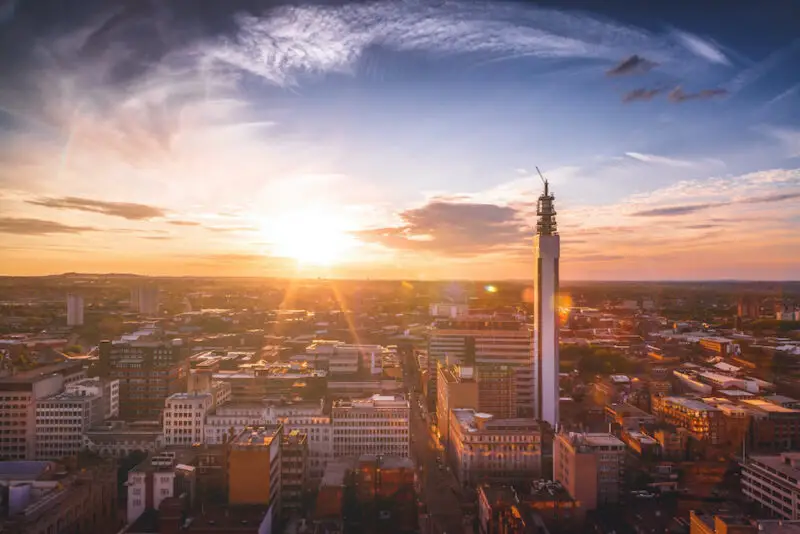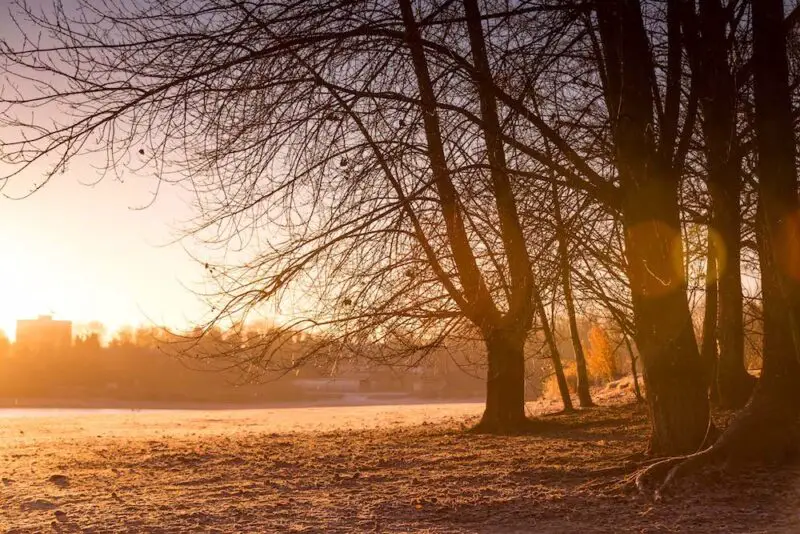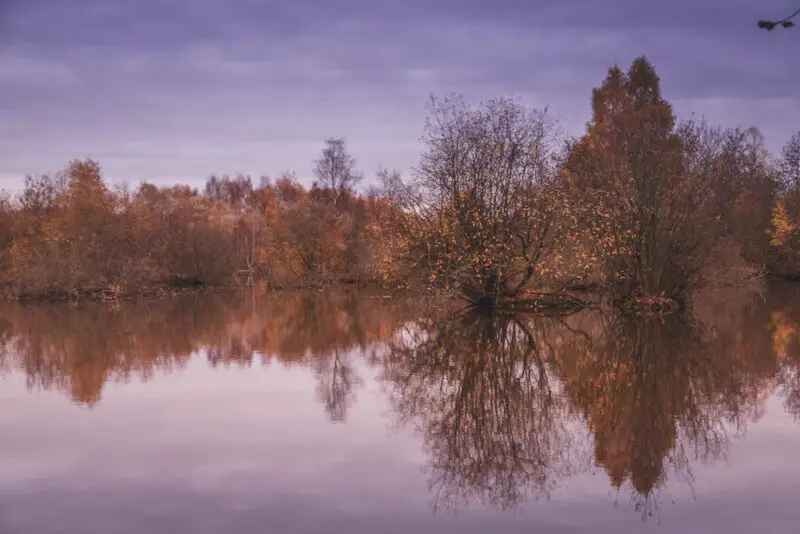Autumn is one of the most beautiful seasons of the year. The day becomes shorter, and the golden hour becomes longer. No matter what you call it, autumn or fall, the leaves are beginning to turn that beautiful orange that we associate with this time of year. And all that is really great for autumn photography.
Vibrant colors offer a unique opportunity for bold autumn photography, but vibrant autumn colors can also be overwhelming and challenging. You might want to photograph a vast landscape filled with changing colors or maybe a fallen leaf with its small details.
Taking creative and beautiful photographs outside has never been better than when the crisp autumn air is blowing. There is no reason to stay sedentary when there are so many beautiful colors to choose from. So, you will find a variety of tutorials structured to suit your style of photography within this guide to help you make the most of this stunning season.
- Plan Your Autumn Photography Trip
- Telephoto Lenses Work Well For Autumn Photography
- Use Wide-angle Lenses
- Use Natural Framing
- Take Pictures During The Golden Hour
- Pay Attention To Details To Enhance Your Autumn Scene
- Autumn Photography Requires A Good Angle Of Light
- Keep Away From Direct Sunlight
- Change The White Balance Setting
- Make Sure You Use A Polarizing Filter
- Use Various Composition Techniques
- Photograph Autumn Landscapes
- Use Exposure Bracketing For HDR Autumn Photography
- Autumn Photography Means Taking Advantage Of Overcast Days
- Use Autumn To Your Advantage For Great Outdoor Portraits
- Take Low-angle Shots To Capture More Depth
- Photograph Themed Scenes And Festivity During Autumn
- Look For The Reflections For Better Autumn Photography
Plan Your Autumn Photography Trip
When you plan ahead, you won’t waste time looking for things to do when you arrive at your destination. The ability to plan will also allow you to ensure that everything has been taken into consideration. Planning in advance will ensure your trip goes smoothly and everyone is satisfied.
It’s wise to do some research first. Look for autumn images on the internet or look for inspiration in books you feel emotionally connected to before going on location. The first step is to know where to go, but timing is equally significant. See when the area’s fall colors were at their peak.
Peak autumn colors can vary greatly from state to state and from town to town as well. You can check the forecast for temperatures and weather to help predict color timing several weeks in advance. Because fall colors arrive earlier at higher elevations due to cooler temperatures, it’s helpful to know where you are planning to shoot.
Telephoto Lenses Work Well For Autumn Photography
Telephoto or telephoto zoom lenses can really enhance the subject. In addition to magnifying your subject, these lenses make it appear larger in the frame. That helps you focus on some of the finer details that you can miss if you use wider angles of view.
Telephoto lenses, however, should be used with caution. As a result of their sheer size, it is almost impossible to hold them handheld without shaking the camera. As the old rule of thumb implies, a longer telephoto lens must be held handheld at a shutter speed of 1/250sec or faster unless it has image stabilization.
With an image stabilized lens, you may be able to shoot at 1/60 sec for a typical 70-200mm or 75-300mm zoom.
In addition, a telephoto lens will limit the depth of field. The depth of field will appear shallower if your focal length is longer and the aperture is wider. But there’s nothing wrong with this!
If you like to isolate a subject against a blurred background, you will need a telephoto lens set to its widest aperture, usually f/4-f/5.6.
On the other hand, if you prefer a shallow depth of field with everything from foreground to background in focus, you should stop down to f/22. But, be aware that you will lose sharpness due to diffraction at f/22.
Use Wide-angle Lenses
In order to capture far-reaching, dramatic compositions, wide-angle lenses are just the right tool. By stretching the perspective as well as elongating the scale, they enable the elements to appear further apart.
When shooting at small apertures, such as f/16 or f/22, you can capture everything in focus because the depth of field is so large. You might lose some sharpness due to diffraction, but you will gain dramatic sun stars as an added bonus.
Use Natural Framing
In landscape photography, natural framing is a technique that involves placing the primary subject in a position where accompanying elements surround, highlight, or draw attention to it. In their images, photographers should make good use of space and be creative in their use of it. The use of natural framing conceals distracting elements and strategically fills in areas that would otherwise be inert.
An object framing the subject should be connected to the subject itself. By framing a composition, a viewer can focus on a specific location within it.
Objects that surround the primary focal point, whether natural or manmade, are unified by it. You can frame your main subject with branches, leaves, trees, or other natural elements. As a result, you’ll have a nice and interesting frame around your main subject while still emphasizing it.
An image created from these objects gives a sense of depth. Additionally, it identifies the environment in which it was created. A good composition is best achieved through natural framing, and there is no shortage of opportunities during autumn.
This technique will be easier to perform if you have a telephoto zoom or at least a 50mm lens. It still works with a wide-angle lens, but it’s hard to find efficient frames, and the depth of field is different.
Take Pictures During The Golden Hour For Better Autumn Photography
It is known as the light of dreams. But, like all good things, it does not last long. You can define the golden hour as the short time interval right after sunrise and just before sunset when your frame bathes in soft, amber tones.
Golden Hour is the preferred time for many photographers because of its naturally flattering and warm light. The shadows are softer, but the tones are very varied during Golden Hour. Consider your exposure when the light and colors change with the angle of the sun. The trick to taking better, richer photographs is simply to time your shots correctly.
Perhaps autumn is not the sunniest season of the year. Nevertheless, golden hour still comes with its warm, soft, and directional light. That is ideal for photographing autumn’s golden colors.
Using the sun as a key light is best for classic portraits. In other words, you can use the sun to light most of your subjects for classic portraits. The sun also can be used as a backlight for silhouettes or as a sidelight for atmospheric portraits.
During this time of day, you can find compositions that include cloud patterns in the sky. You can enhance your composition with the combination of colors in the clouds. Seek out cloud formations that mimic or complement the shapes of other elements in your scene.
Moreover, overcast skies are usually accompanied by weather and temperature changes. These changes can cause atmospheric conditions such as rising mist from a water source, fog in a forest, or intermittent rays of sun peeking through the mist. These elements can all add interest to an autumn color scene.
Pay Attention To Details To Enhance Your Autumn Scene
Whether it’s a reflection of a colorful tree, a red leaf in a puddle, a dying branch, or a cluster of colorful trees, each one adds to the whole.
Experiment with macro photography during autumn if you really want to demonstrate your creativity. Changing seasons brings new landscapes. That means you can take detailed pictures of nature’s elements. Focus on your subject when you take autumn photos, whether it’s the colorful leaves or the bokeh backgrounds. Bring out the colors in your portraits and discover the details in nature.
Take your time to explore your location. Take everything in. The images you capture could be completely different than what you intended.
For example, you can take a close-up photo of a single fallen leaf and capture all the details. The high contrast of the shot makes the veins and structure of the leaf more obvious when backlit. It creates a saturated image filled with bright colors as the colors become more vibrant.
It does not have to be leaves that take your attention. Mushrooms are a very popular autumn subject for photographers. You can use them to introduce scale into a miniature scene. When viewed from an ant’s perspective, a cluster of mushrooms can appear as a magical forest.
Instead of using the wide-angle lens, use a telephoto or macro lens. Take a closer look at the various objects and scenes to see what catches your eye. Find your preferred depth of field by adjusting your camera settings. The results may surprise you.
Autumn Photography Requires A Good Angle Of Light
In order to boost colors, you need to capture the right angle of light. That depends on where and how illumination falls on your scene. Angled light helps to give your subject shape and texture.
Backlighting is a great technique for enhancing colors. It is the light that shines through the leaves of the autumn foliage that provides illumination around the edges of these leaves, displaying the sheer transparency of autumn foliage. Photographing backlit landscapes with autumn colors can pose challenges, but it results in vibrant and bold colors.
You can also use side-lighting to showcase your subject. Ensure the light has an angle of roughly 90 degrees to the camera when using this technique. Adding side-lights to your compositions will add depth and dimension to your photos.
To emphasize the colors in your shots, try framing them in a way that contrasts the different tones: an orange leaf on a blue sky, a red leaf on a lush green lawn, etc.
Keep Away From Direct Sunlight
Sunlight will cast shadows on the subject, reducing color saturation and causing lens flare, which further reduces color saturation. When it’s sunny, make sure the sun is at your back. Whenever you have to shoot into the sun, use a lens hood or shield your lens to prevent lens flare.
The main challenge of photographing directly into the sun is the underexposure of the foreground. That means multiple exposures need to be captured and blended together in post-processing.
But, if you decide to take pictures of the sun, make sure it happens at sunrise or sunset. When photographing in the sun, it is essential to use the elements in the scene to partially block or diffuse the light.
The best thing you can do is frame the sun so that only its rays are visible. In this way, the image appears warm and cinematic, and something magical is revealed on the horizon. A small aperture, such as f/22, is ideal for creating a sunstar effect.
Change The White Balance Setting
When photographing autumn, you might use the Auto White Balance function on the camera, but it tries to neutralize colors, which is not what we want. The best way to achieve that warm color is to adjust the White Balance manually.
Therefore, feel free to warm up your images by changing their temperature. During the autumn season, nature overwhelms with warm tones. So, to ensure your images complement your surroundings, be sure to use warm temperatures and a white balance for your photographs.
If you want your images to come out the way you envisioned, change these values before you begin shooting. You can use a higher Kelvin number (such as 6000K) to achieve this. But don’t overdo it. Too high a value leads to a global, unnatural color cast. Do not worry if you forget to make the adjustments. You can also make them after the shoot in post-production.
Make Sure You Use A Polarizing Filter
Whether you are photographing in the woods or on a scenic vista, the circular polarizer filter is exceptionally useful in the autumn. There are several benefits to using one. It adds contrast and enhances color. On a clear day, it brings out the blue sky, during a rainy day, it reduces glare. Also, it allows you to use a slower shutter speed. It is helpful when photographing rivers.
It can be challenging or near impossible to fix glare reflected off the foliage in post-processing caused by cloudy and overcast days. So, a circular polarizer is a must for removing unwanted glare.
Filters like these reduce light transmission by two stops, creating a silky, moody effect with moving water. In addition to a standard circular polarizer, warming polarizers are a great option to use at this time of year for boosting warm-toned colors and accentuating autumnal tones.
Since the polarizer darkens the image up to 1.5 stops, you may need to use a tripod or increase your ISO to get a sharp image when there is less light available. You want the filter to enhance the colors in the scene, not create a significant color cast. So make sure you choose one that is relatively color neutral.
Use Various Composition Techniques For Better Autumn Photography
Composition is one of the most effective ways to tell the story you have on your mind. Use unusual angles to accentuate the colors of autumn. Autumn images are usually shot at eye level, but that doesn’t have to be the case. Don’t be afraid to shoot at different and sometimes unusual angles.
A good example is taking autumn foliage photos from ground level. From the ground, the landscape appears entirely different. With this perspective and a wide-angle lens, you can add depth and accentuate the size of objects. You can draw viewers’ attention closer to foreground details with the wide-angle lens. Frame the scene with foreground elements in the foreground.
The most obvious choice is to take a wide-angle shot, but consider taking a telephoto shot as well. That way, you can easily arrange color and form in a simple but effective manner.
Finding higher ground above your subject and shooting from that vantage point is another option for changing your viewpoint. It is also possible to isolate patterns only visible from the air using a drone’s elevated view.
A macro lens is a good choice as well. There are so many textures and patterns on a single leaf. Using a macro lens, you can examine these details from a different perspective and create abstract compositions.
You will come away with a portfolio of photos that tell the story of fall color from various points of view if you combine these lens types and composition methods.
Photograph Autumn Landscapes
Autumn is the ideal time to photograph landscapes. You can take them in many different ways.
If you want to take autumn pictures that are bright and beautiful, spend a day in nature. That way, you can photograph your favorite nature spot at the beginning of a new season. During the golden hour, capture those moments when the leaves gently fall from the trees.
Sometimes it is difficult to capture a scene because there are so many distracting details. In this scenario, you can use a telephoto or a prime lens with a wide aperture. Shallow depths of field help blur distracting elements out of your photo.
You may, however, wish to capture more details. Using a narrow aperture like f/16 will give you a more detailed autumn photograph. You will be able to capture the whole landscape properly and have everything in focus.
Sometimes the scene is so spectacular that it is impossible to capture it all. Wide-angle lenses provide more perspective. However, you’ll need a strong subject that shows depth and perspective in your photo. Bear in mind that you might get distorted landscape photos if you take them from an incorrect angle. Be sure to keep the camera level when taking photos.
Use Exposure Bracketing For HDR Autumn Photography
With fall colors, it’s wise to bracket the exposures when you are trying to capture the finest colors and details. Especially during the golden hour, when the light can be harsh with sharp contrasts.
Use a tripod and shoot a minimum of three exposures. The first exposure is two stops underexposed, the next is a “correct” exposure, and the last is two stops overexposed. Then you can merge these three exposures into one HDR photo via Lightroom or Capture One. The HDR photo holds up better with greater shadow and highlight recovery and has a lot less noise overall.
Experimenting with exposure bracketing allows you to edit photos in a way that allows you to bring out shadows without noise. Additionally, it allows you to avoid overexposed highlights and enhance colors without posterization.
Autumn Photography Means Taking Advantage Of Overcast Days
Autumn’s magic is not only found in sunny images with orange leaves. Do not underestimate the beauty of misty and rainy weather. So, on days when the sun isn’t shining, some people keep their cameras in their bags, but those can sometimes be the best times.
The overcast days help to create a mood that you can’t get on a sunny day – plus, the images look nice and rich on these days. Autumn isn’t a season that offers sunny days on a daily basis. When autumn starts, daylight hours become shorter, and the weather changes rapidly. That usually means rain, fog, and gray days.
Even though you might want to stay at home under a warm blanket with a cup of hot cocoa, keep in mind that the changing weather can create amazing moments in front of the camera.
Lakes, woods, rivers, and streams make good subjects for autumn photography on overcast or foggy days. In addition to the Golden Hours, during these days, the light is more forgiving than it used to be, making it easier to take interesting pictures at any time of day.
Using an umbrella for portrait photography in the rain is a good idea. It can also be rewarding to photograph the streets after heavy rain, with large puddles reflecting urban landscapes. So, feel free to explore and seek out scenes that stand out from the background.
Use Autumn To Your Advantage For Great Outdoor Portraits
You can capture some flattering portrait shots during autumn. You’ll get some impressive shots if you pose your subjects in their fall surroundings. The scenery and the background should dominate your images if you want to incorporate the environment.
A portrait session among the multi-colored trees would be ideal for a couple or a family. By coordinating the props and wardrobe, you can make the most of it. You can use a palette of earthy tones, like mustard yellow, beige, brown, dark purple, or orange colors to fit the scene.
You can also use fairy lights in the autumn to add a touch of dreaminess to your photoshoot. If you place the fairy lights in the background, you can add a cool bokeh effect to your portraits. To add glowing details to your photo, you can put them in a lantern and have your model hold the lantern in their hands.
You can also create exciting compositions by throwing leaves. Throwing leaves at your subject during a pose will make this idea more interesting. In this way, your model will be able to pose freely.
You can’t hold your camera while throwing leaves at someone. Consider using a tripod and a timer, or ask someone to throw the leaves for you.
Nevertheless, because of the popularity of this idea, your photos might end up looking like every other autumn photo.
Make them look less boring by using a different focal point. You don’t always have to put the subject in focus in your portrait. If you want something abstract, try f/1.8 or f/2. As the person tosses tree leaves in the air, pull your focus from them. You can turn your subject into a blurry outline by focusing on a couple of leaves instead of your subject.
Take Low-angle Shots To Capture More Depth
The beauty of autumn photography lies in the surroundings and colors of nature. If you shoot from a low angle, you can get more of the foreground and background included in your photos. In this way, your image will look more balanced.
An autumn tree, for example, can be beautiful on its own. When you get down low to the ground and show the leaves in the foreground, you can see the details of the leaves in more detail. Additionally, the leaves beautifully contrast the blue sky.
Low angles are ideal for framing the entire fall scene. That is a great choice when you have a lot of large trees, a lot of leaves, and a large expanse of the sky to photograph.
Photograph Themed Scenes And Festivity During Autumn
The autumn season offers some breathtaking scenery and festivity. Focus on these features if you wish to get some standout images. Pay attention to what makes autumn yellow and orange. The orange leaves and harvest celebrations such as Halloween and Thanksgiving are a hallmark of autumn. Photograph the scenery during fall.
There can be a lot of Halloween props and decorations with scary and dark scenes. Another option is to capture children asking houses for candy. Additionally, you can take a lot of Halloween photography images with pumpkins. Apart from using them for Halloween pumpkin carvings, these vibrant props are great for baby portraits as well.
https://www.youtube.com/watch?v=L4FoeCwrRcs
You can carve a pumpkin with holes, so the baby can sit in it and poke their legs out. Photographers of children and families might want to try baby portraits like this one if they want to boost their creativity.
Just like Halloween, Thanksgiving also has its own autumnal ambiance that you can capture. The season is about harvests and sharing. Thanksgiving is all about sharing, eating, and receiving. You can best capture this holiday season by hosting a family dinner. Spend some time taking pictures of your loved ones and the delicious food on the table.
Look For The Reflections For Better Autumn Photography
Reflections in autumn make for stunning compositions. Find the best reflection spots for autumn photography in order to make it even more nature-focused. You will notice that the surrounding environment reflects on the surface of most bodies of water, especially lakes.
During the autumn season, it is especially captivating. It sparkles in the water below as the boost of color appears on the trees. It doesn’t matter if it’s sunny or foggy. These autumnal visual compositions always make for stunning autumn photography.
